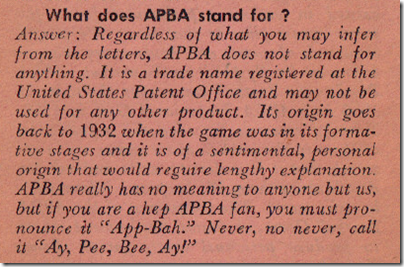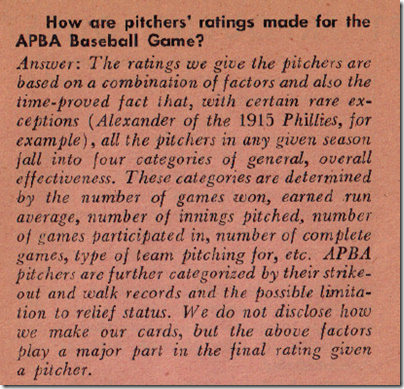This week, Flashback Friday features a gem from Scott Veatch’s Vault that I found pretty interesting. By my guess, it came out in the late 60s (edit: Scott says it came out in 1964) and it’s a list of commonly asked questions by phone callers. I suppose in today’s lingo, it would be called a list of Frequently Asked Questions (FAQ).
APBA started out the Q & A form in this manner:
“Over a period of years, the same general questions are repeatedly asked by our customers. In order to save a good deal of repetitious correspondence we have prepared this Question-and-Answer form. Perhaps the answer to your question will be found here.”
I probably make a blanket disclaimer that any statement made in this pamphlet was the policy of the APBA Company back 40-50 years ago and not of today’s APBA Company.
This first screen cap got my attention. The question asked if the APBA fans could make their own cards.
APBA answered in part: “There is nothing to prevent you from trying…” with the usual disclaimers that it might not be up to APBA’s quality. “However, if you just want cards with names to fill out your roster and you do not care about accurate results, you may certainly try to devise your own cards.”
As mentioned in other articles, the question, “What does APBA stand for” has probably been asked a lot.
I enjoyed this attempt to quell the rumors especially this bit:
“APBA really has no meaning to anyone but us but if you are a hep APBA fan, you must pronounce it “APP-Bah”. Never, no never, call it “Ay, Pee, Bee, Ay!”
I appreciate the forcefulness of this answer. None of this “the customer is always right” business. But I say, cool cat, what is “hep”?
I’m sure a lot of APBA fans callers asked the Hoy Grail of questions…”how are pitchers’ ratings made?” Rather than being super-secret about the issue, APBA gave a little insight into the mystery.
APBA claimed that pitchers’ grades were determined mostly by games won, ERA, innings pitched, games pitched and complete games. Further ratings are determined by strikeout and walk records.
That’s nothing earth-shattering for most of us but still interesting from a “how much info did they give out” point of view.
There are a whole lot more questions in the full Q&A sheet that was published by APBA way back when. These few are just a sample. You can see the whole Q&A sheet here if you want to read it.
Thanks again to Scott Veatch. You can see his growing archive of old brochures and pamphlets here.







What is hip? Do you think you know? If you’re really hip, the passing years will show.
https://www.youtube.com/watch?v=oAatPPEaZDA
The first card I made was Bobby Murcer (the next Mickey Mantle!) in ’66, on a typewriter with a black and a red ribbon.
Tom, I got this brochure in the first APBA mailing I ever received from the company — the summer of 1964. I’m guessing it was printed several years earlier.
Thanks Scott! I was judging by the font they were using. Mid 60s makes sense.
Great stuff! I love how almost particular the company was about how they wanted you to use their product.
I remember that brochure. My friends and I always called it Ay Pee Bee Ay and got a laugh out of being told it was prnounced App Bah. When I went to Mecca back in the 80’s I stopped a mailman for directions to the company and said Ay Pee Bee Ay and he said ” oh you mean App Bah”.
Two quick comments about the APBA FAQ: Was MLB really considering reducing MLB rosters to 20 players? I never heard of that.
And lefty righty splits. How could the company be so wrong? They mentioned four players: Stan Musial, Al Kaline, Orlando Cepeda, and Johnny Callison. Below are their career OPS against righties and lefties.
Al Kaline: .833, .908.
Orlando Cepeda: .829, .903.
Stan Musial: .999, .917.
Johnny Callison: .791, .725.